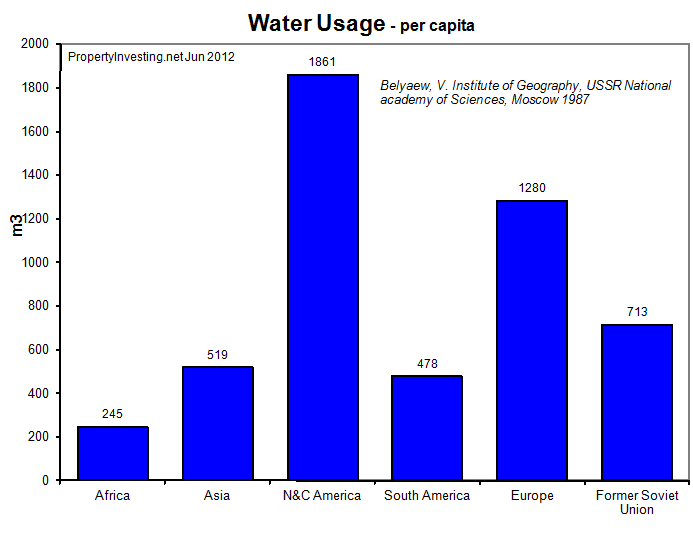|
|
|
|
|
EnergyInsights.net team
It's often helpful to take a look at the overall global energy picture as context to the social, environmental and economic landscape of the world - and people interested in the mining-oil-gas and energy-resources and sectors. It's also good to review, in order to learn more about consumption and production patterns with regard to the environment. We hope this analysis will give you some interesting insights. We will flag some of the main areas of interest through the presentation.
Coal Consumption: Coal is the number one carbon emitting energy source. Coal consumption has dropped in the west from the affects of the 2008 recession and new measures to reduce coals usage - however, this has been dwarfed by the big increase in coal usage in China and to a lesser extent India and South Africa. Clearly all the talk of climate change since 2000 has had very little impact on global coal consumption.
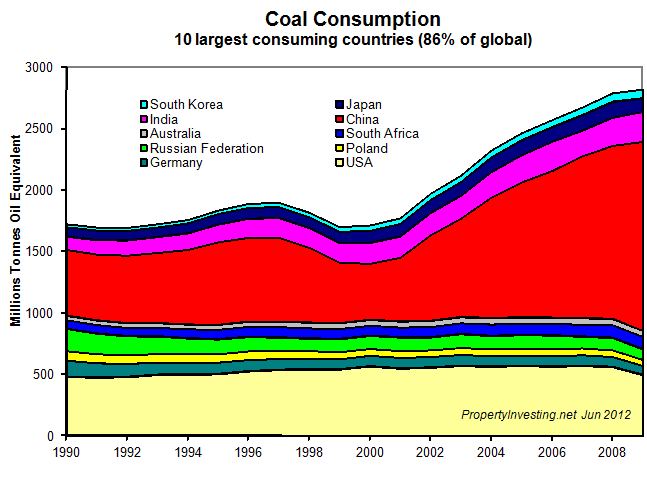
Coal Consumption Per Region: Asia Pacific coal consumption continues to skyrocket with Europe and North America dropping slightly - mainly as consumption has dropped after the 2008 recession.
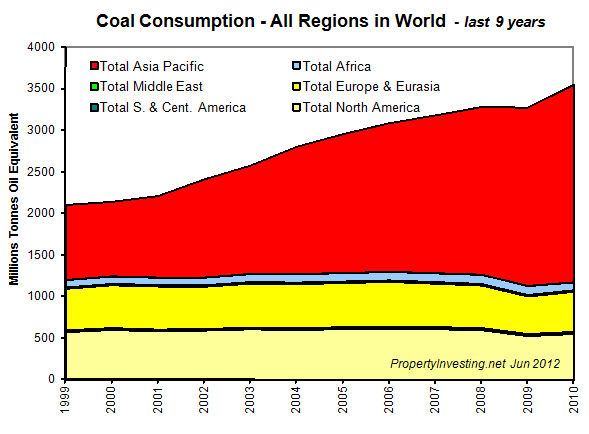
Coal Consumption World: Coal consumption has skyrocketted since 2000 when China increased its power output to fuel growth and economic expansion. This does not show signs of slowing. European coal consumption has dropped to about half of it's previous levels during the Soviet era (pre-1986).
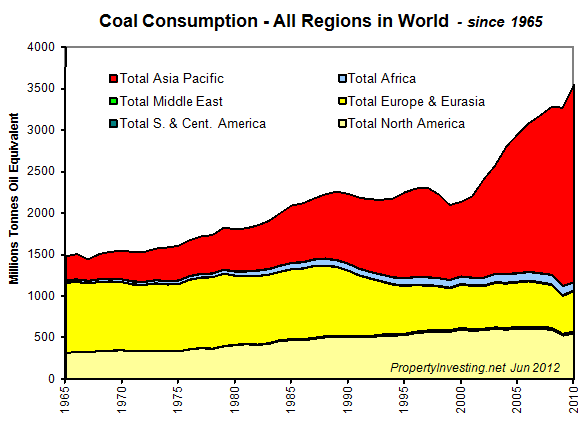
Coal Prices: Coal prices have risen sharply since 2003 (along with oil price and other energy prices). US coal prices have dropped back after Shale Gas started significant economic production from about 2006 onwards, as gas began to offset coal usage in the State (natural gas prices crashed from $12/mmbtu in early 2008 to $2/mmbtu by mid 2012 making gas lower cost than coal and oil). Coal prices remain very high for Japan as they compete for imports with China. All Japanese energy costs are very high (gas $12/mmbtu, oil $100/bbl, coal $165/Ton, nuclear might now be phased out).
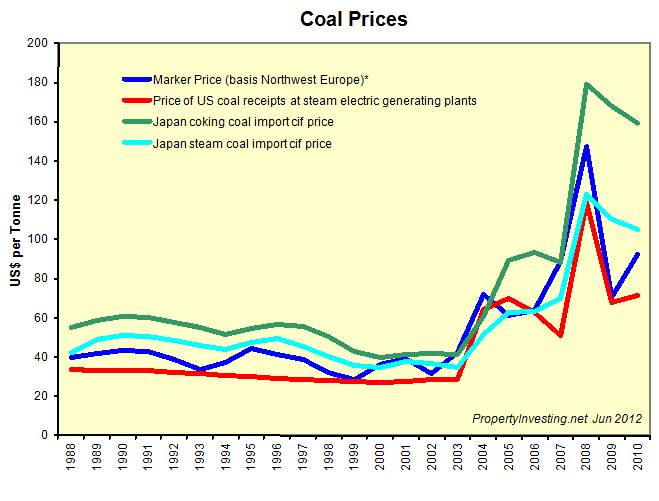
Coal Production Region: This shows production from 1981 onwards.
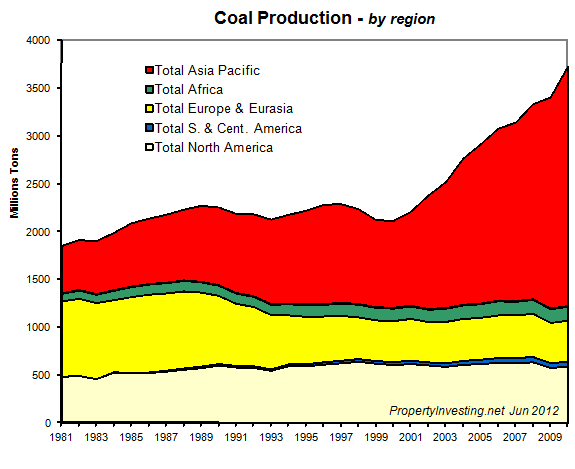
Coal Reserves Region - Coal reserves are split fairly equally between Europe, Asia and North America - this interestingly also matches GDP patterns fairly closely. South America has very low coal reserves, and Africa fairly low considering its area/size.
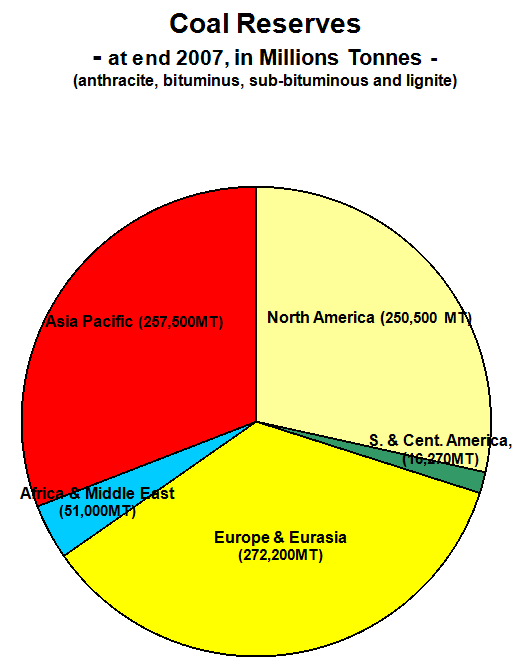
Coal Reserves Country: "King Coal" is the USA, followed by Russia and China. Little wander these are some key countries that are not keen on the Kyoto agreement to reduce CO2 emmissions.
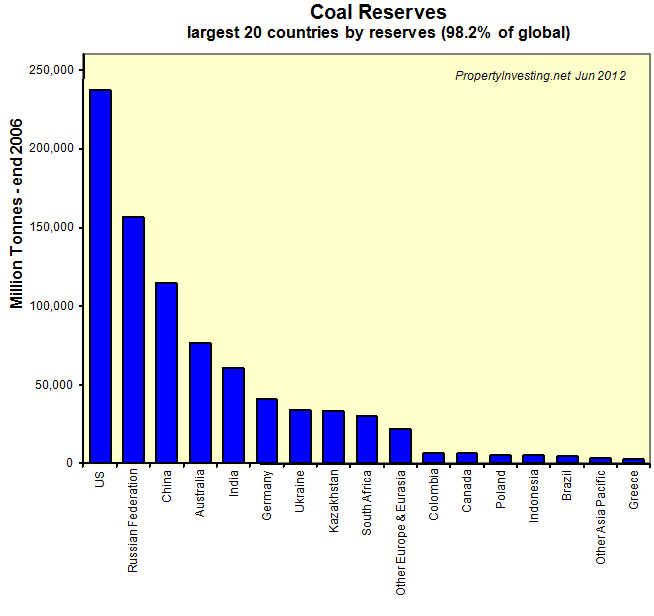
Crude And Product Imports and Exports: This diagram shows the main exporters and importers of crude oil.
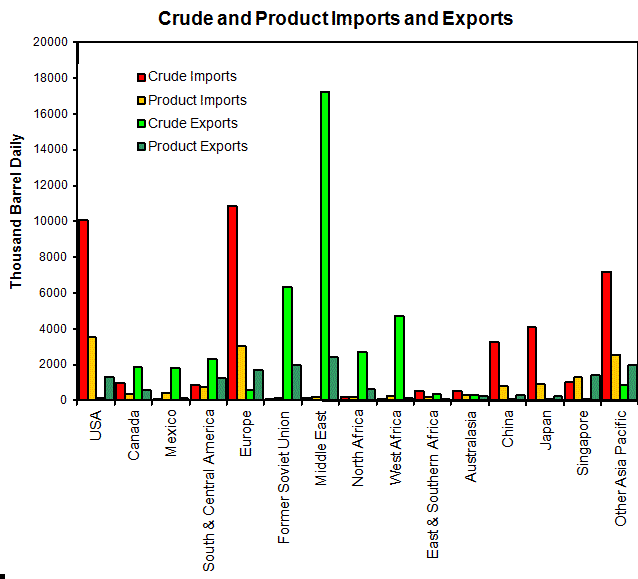
Electricity Generation - Largest Countries: Electricity consumption has almost doubled since 1990. As the middle classes have expanded across the world along with GDP and population, along with computer-household usage, its little surprize electricity is a big growth area. Companies like GE and Siemens making power turbines are able to capture these opportunities.
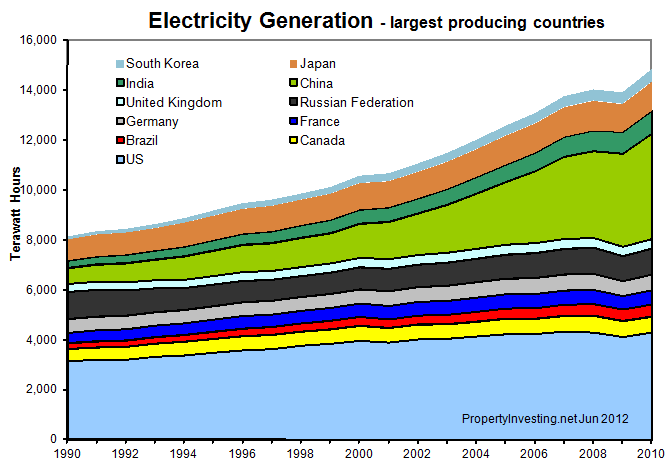
Electricity Generation Per Region: Asia Pacific has seen its electricity generation expand from 2.5 to 7.5 Terawatt Hours since 1980. The region is now the biggest electricity generator by far.
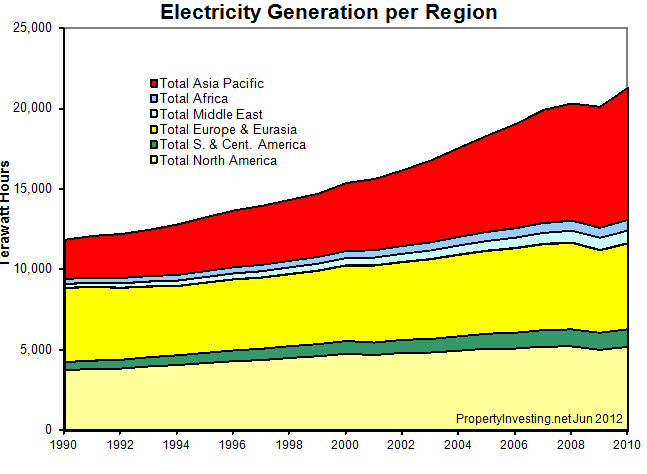
Oil Price - oil prices is still lower in real terms than in 1980 and the 1860s. The period 1986 to 1999 saw huge growth in western developing nations as low oil prices fueled economic expansion and prosperity. This came to an end in 2005 when oil prices rose sharply - and stagnation looks likely with oil prices above $75/bbl acting like a huge tax on western growth. Expect stagflation with oil prices >$75/bbl and recession with oil prices over $115/bbl.
.gif)
Coal Reserves: This is the high quality coal reserves - China and the USA are dominant. This is the cleanest burning high calorific value coal, with highest prices.
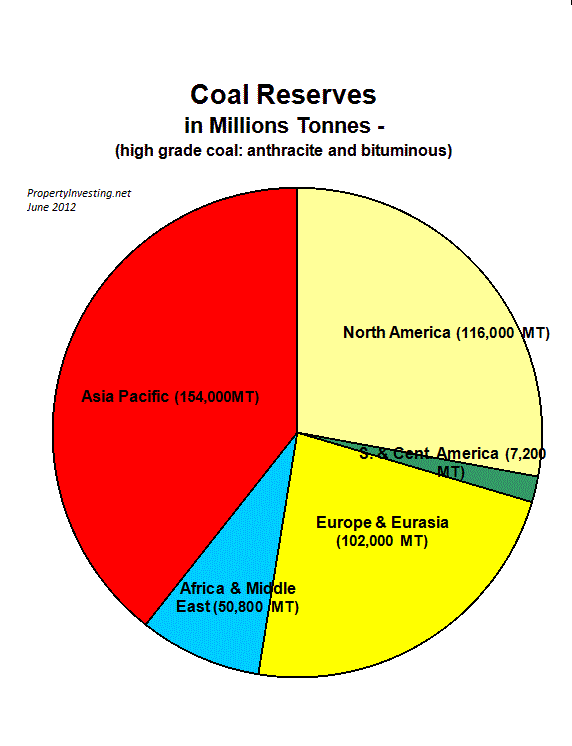
Coal Reserves: The below chart looks at low grade "dirty" coal. Russia and eastern Europe have largest reserves of this dirty brown coal (high in water, sulphur and impurities). Much of this consumption was shut down after the collapse of the Soviet Union in 1986 - which led to cleaner air and a warmer climate (letting the sun through the smog) in Eastern Europe towards Siberia. Siberia then warmed dramatically and this has led to methane being expelled from the thawing Tundra regions - releasing these pure greenhouse gases - this will then warmed Russia-Siberia even further. Hence our view, is that the lack of this dirty coal usage in part led to a big increase in global temperatures from 1986 to 2003. The "global dimming" of dirty particulate pollution keeps the world cooler than it would otherwise be.
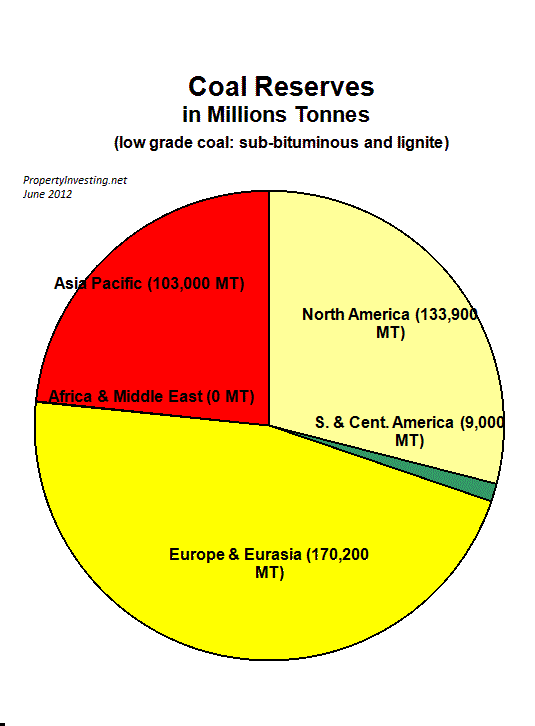
Hydro Electric Power Consumption: Hydro-electric power output continues to rise. The US hydro-electric power generation is an excepton - it drops - probably because of droughts and water shortages. The chart shows growth in hydro-electric power consumption per nation over time (normally indigenous to a specific nation) - the top 15 hydro-electric producers.
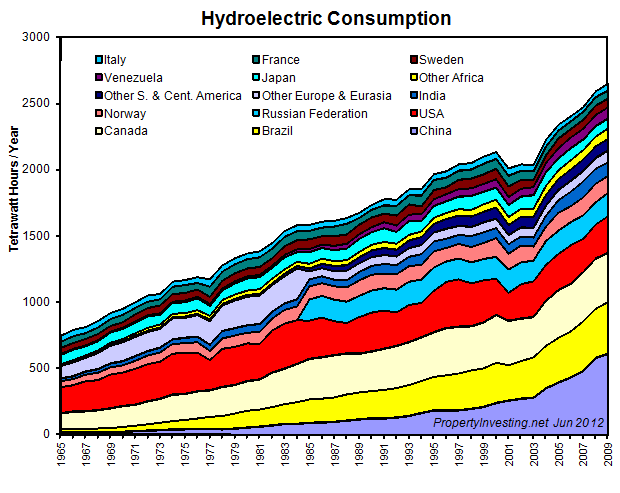
Hydro Electric Power Consumption - Per Region: Hydro-electric power output and consumption has risen dramatically in the Far East (China).
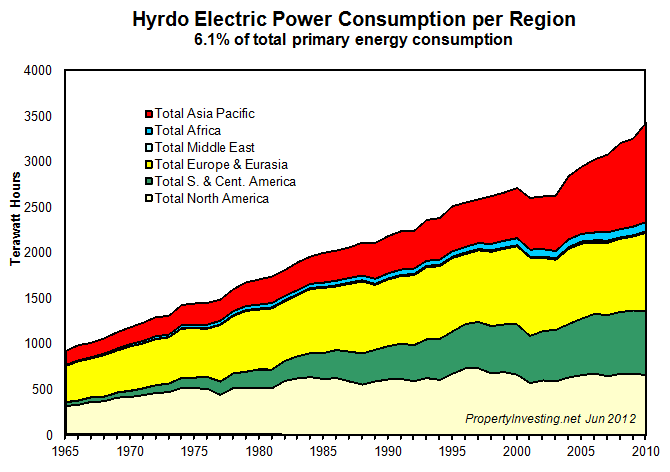
Hydro-Electric Power Consumption: This chart shows growth in hydro-electric power consumption per nation over time (normally indigenous the specific nation) - top 27 hydro-electric producers.
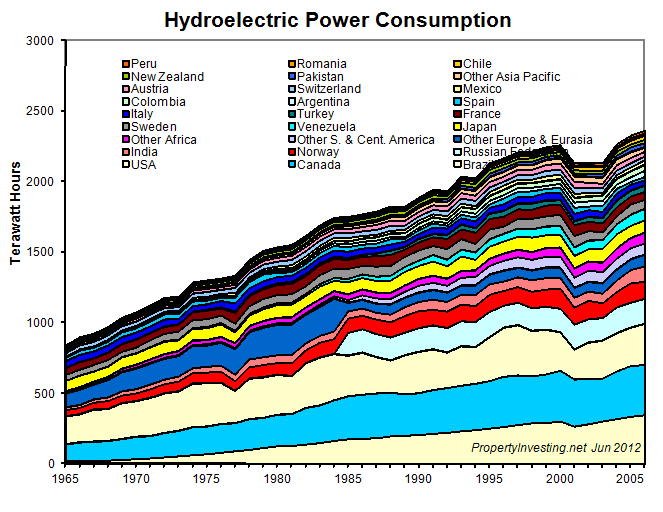
I
mports of Oil - Trade Movement - Per Regions: Movements decline in North America and Europe whilst increasing in the Rest of the World (China etc). There is a short dip during the 2008-2009 western recession, though Rest of World continues to increase during this period.
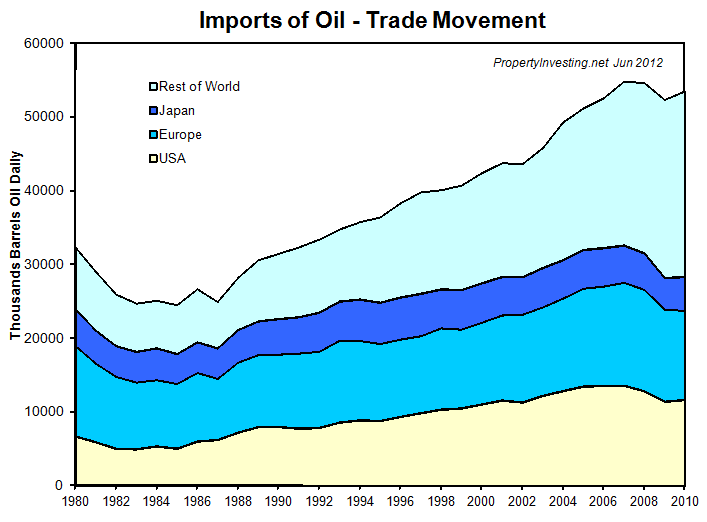
Nuclear Consumption: Nuclear consimption is on a plateau of sorts. Germany and Japan will likely decline whilst China increases. France may also drop of the new grovernment curtails upgrades.
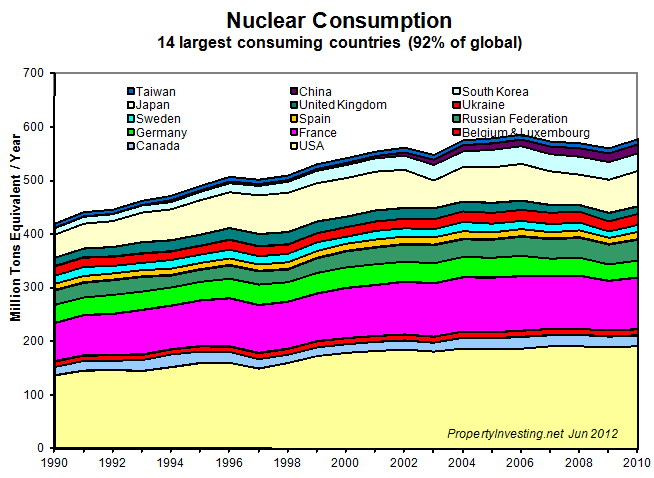
Oil Exports Trade Movement : Exports of oil continue to increase though dropped briefly during the 2008 western recession. If another recession hits, trade movements are likely to dorp once more.
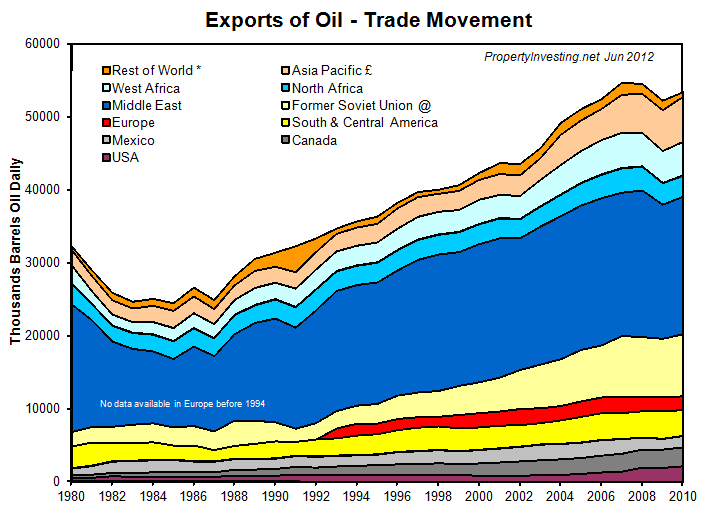 .
.
Oil Price - Real Terms and Nominal - Oil prices are close in real terms to their peak in 1980. Any oil price of >$75/bbl normally will trigger recessions in indebted western nations that import large amounts of oil (most of Europe, USA).
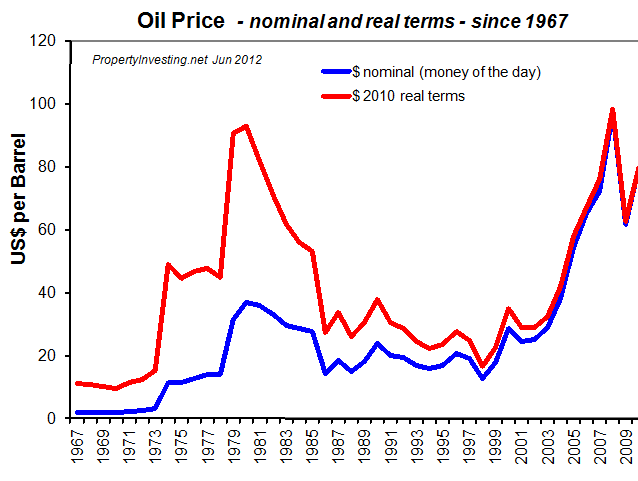
Oil Refinery Capacity Europe: This has been in decline since 1977 as oil usage has dropped (energy conservation improved, gas usage increased, growth has slowed). Oil refining in Europe is a dying business - more refineries will close over the next ten years.
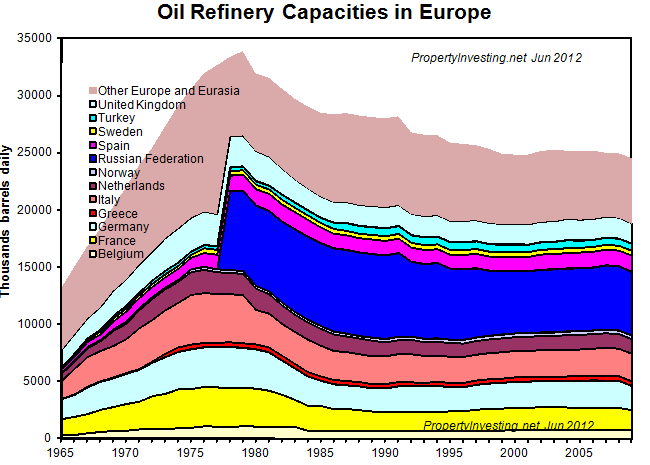
Oil Refinery Capacity Global Per Region: Oil refinery capacity is dramatically increasing in Asia Pacific and declining in USA/Europe but expanding in South America, Middle East and Africa. This follows oil consumption patterns and GDP growth patterns. Refining in USA and Europe is a dying business.
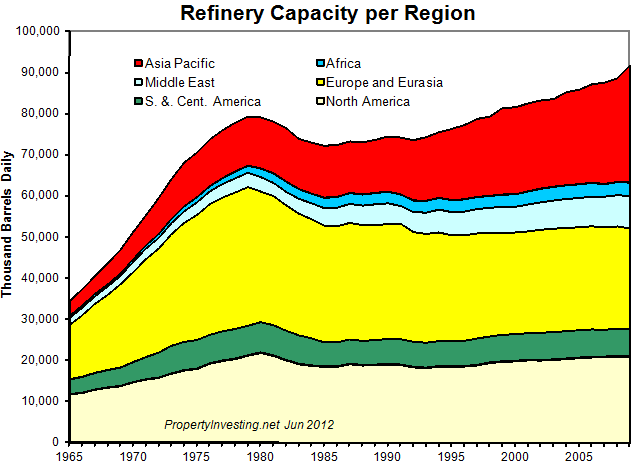
Oil Refinery Capacity Middle East: The Middle East oil consumption is sky-rocketting - as this increased refinery capacity is also increasing. The huge increase in middle class energy usage and expanding population is driving this refining increase.
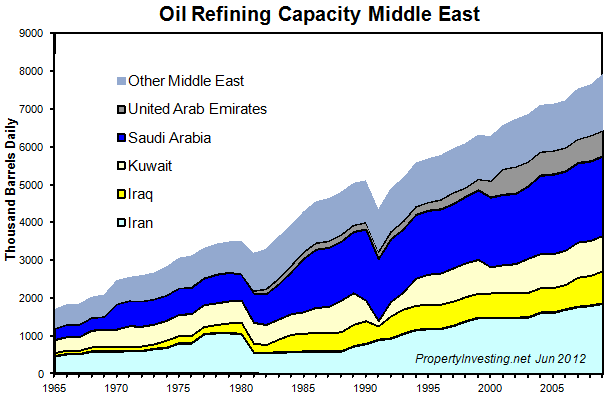
Oil Refinery Capacity - North America: This is fairly constant, though will likely drop into decline as more natural gas is used for transportation in the next decade. A dying business.
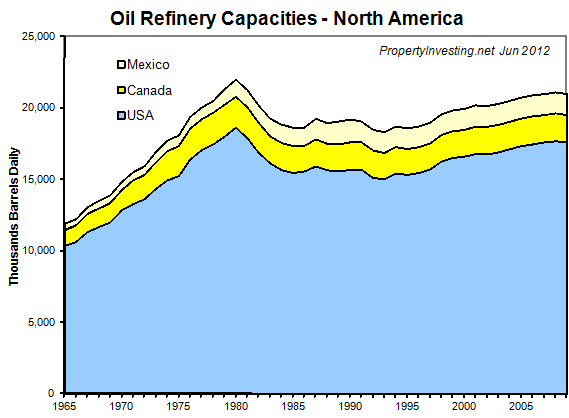
Oil Refinery Capacity - South America: Oil refining capacity crashed in 1984 during the financial crisis in the region and has still not recovered (along with oil prices skyrocketting in 1980 after the Iranian Revolution).
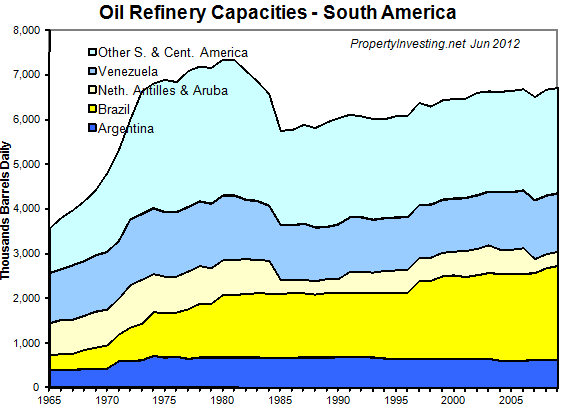
Oil Refinery Capaicty - Asia Pacific: Continues to sky-rocket, mainly driven by China.
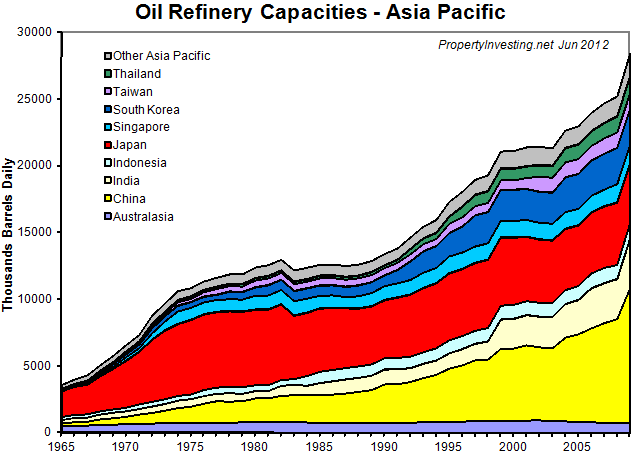
Oil Refinery Throughputs - Global: These increased to 73 mln bbls/day - are are now on a plateau. Recall that Peak Oil (crude oil) was 2005 - it has not increased significantly since then. Hence no further overall capacity is required. It's likely refineries will shut in Europe and USA and open in Asia (China) and the Middle East.
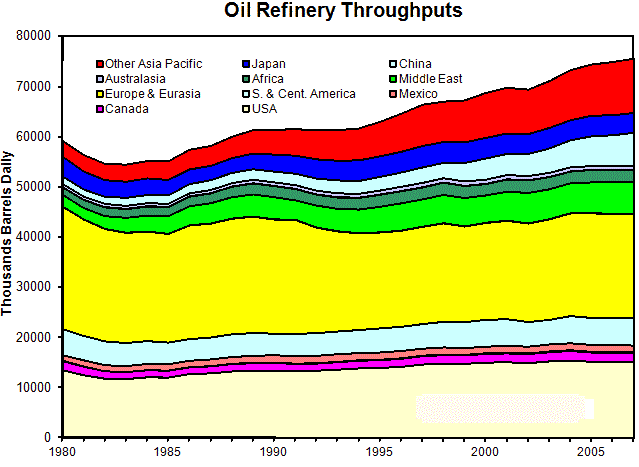
Nuclear Production: Peak Nuclear Power was 2006. The recession of 2008 triggered a decline, this is now accelerating as Germany and Japan close nuclear power plants after the Earthquake of 2011. Despite it's very low carbon emmissions and good long term economics, its looks like being a dying business in most counrties.
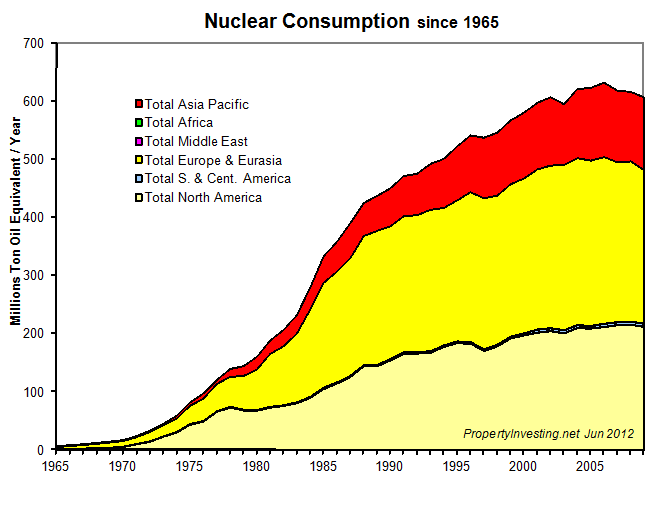
Primary Energy Consumption Largest Countries: Primary energy usage increased up to 2008, but without China it would have decreased.
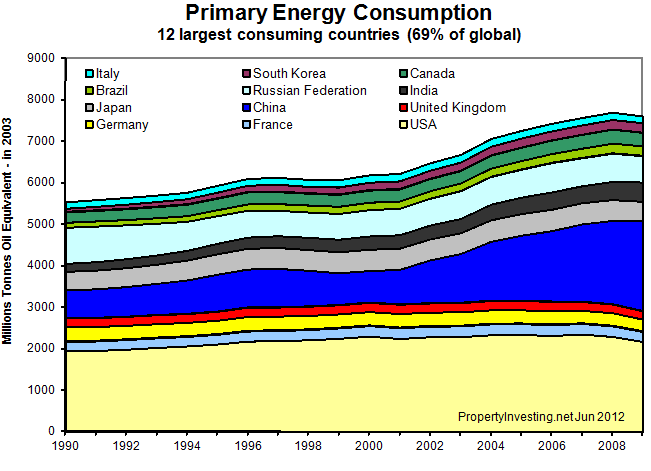
Primary Energy Consumption - This peaked in 2008. This might continue to drop globally if there is another recession in 2013. It looks like China's growth has come as the western world goes into decline. This is not surprizing because there are only enough economic resources to go around - so China's growth must come as other areas decline. Globalization shifted manufacturing to China, and the west raised debt to pay for these cheap imports. China grew, the west grew but mainly through unstainable debt. China indirectly tipped the west into recession as oil/coal/energy prices skyrocketted from 2005 onwards.
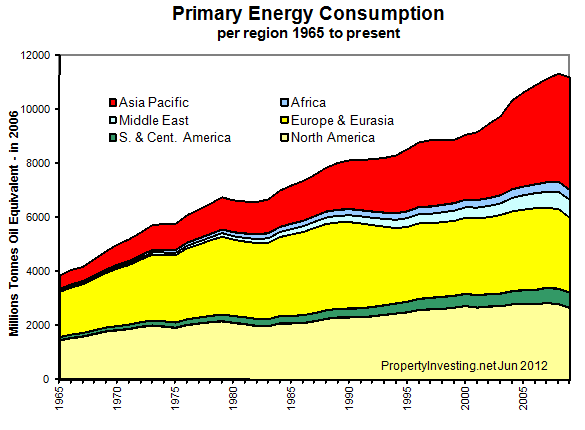
Primary Energy Consumption Per Region: Ths is a snap-shot for perid 1990 to 2010.
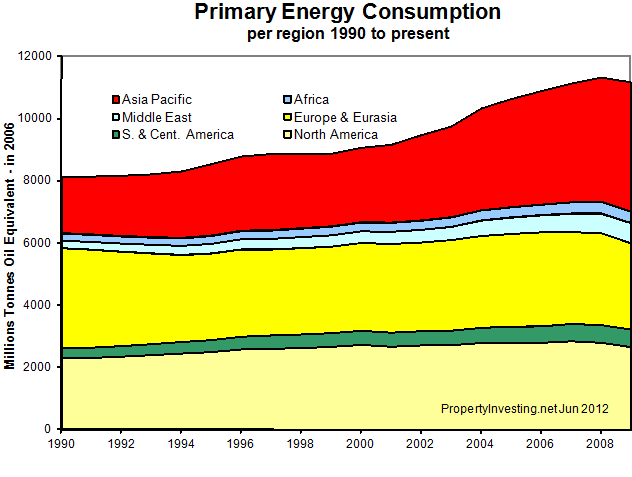
Primary Energy Consumption - Regional: Asia Pacific is by far the largest primary energy producer now. the bulk of this is coal. Europe and USA have similar mix, size (and GDP). Asia Pacific now uses more oil than any other region. The USA's dominance in energy is now ended - North America is third place behind Europe.
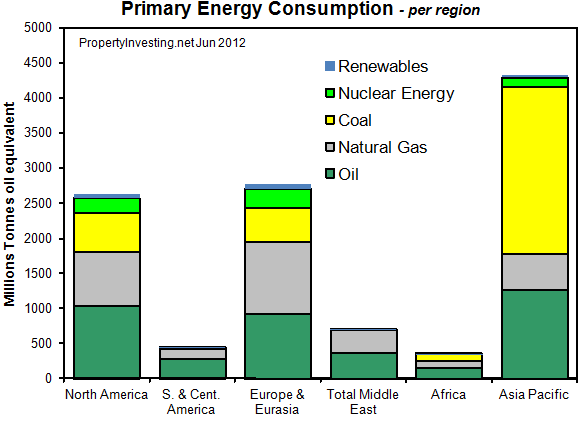
Refinery Utilization - Largest Refiners: Massive overcapacity in the period 1993 to 2000 in Asia Pacific led to 67% utilization - this increased to 87% by 2008. Mexico and Canada utilisation has been close to 100% recently. The utilisation converges suggesting refinery closures has matched refiner capacity and output (less overcapacity).
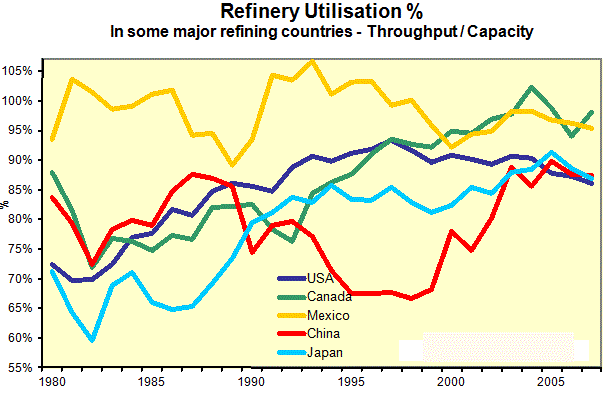
Refinery Utilization Per Region : After the oil crisis and recession in 1980 triggered by the Iranian Revolution and instability in the Middle East (spike in oil prices) - refinery utilisation has increased overall from ~72% to ~85%. North America utilisation however has dropped since 1997 - indicating demand for oil has dropped. Asia Pacific utilisation has increased from 62% in 1984 to 86% in 2007.
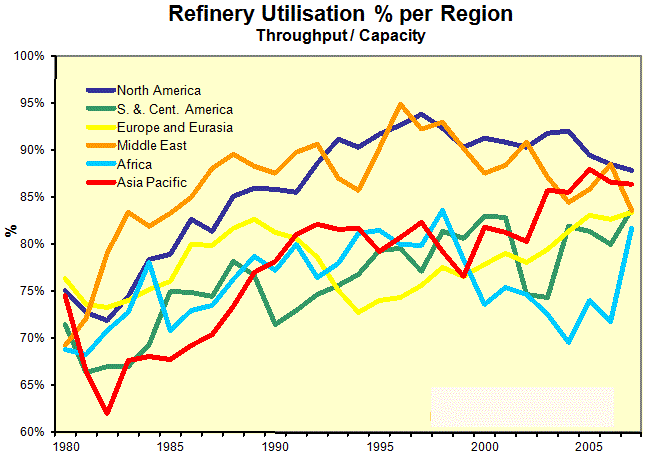
Trade Movements -Oil Imports Per Region: have risen sharply in Asia Pacific, North America, declined in Japan and increased slightly in Europe since 1992.
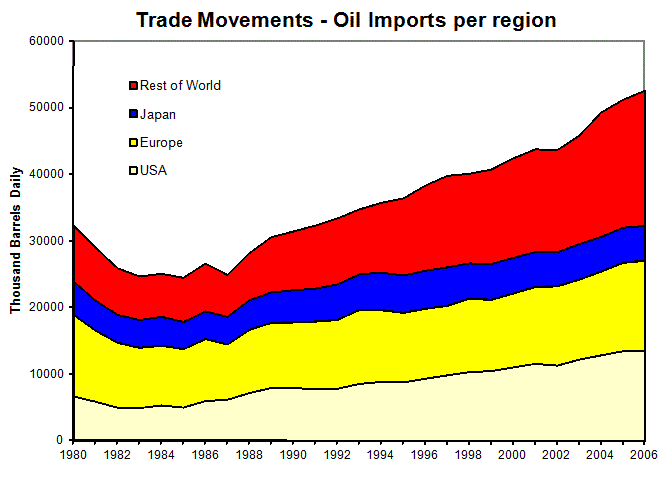
Water Usage Per Capita : Water consumption in North America is close to ten times that in Africa, and four times that of South America and Asia. Europe is also a large water user. It is antipated that Asia's gigantic increasing middle class consumers will use far more water in the next 20 years - the water business is a good business in Asia. Water is also needed for oil and shale gas production - fraccing, water injection and processing heavy oil sands. We expect water usage to rise sharply in all regions and water resources shortages to occur as supply does not meet demand. Water purification, water sourcing-drilling and other water services are likely good long term investment.
